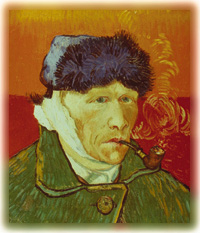Main Menu · Search ·Current Issue ·Contact ·Archives ·Centennial ·Letters to the Editor ·FAQs

|
The career of Vincent van Gogh (1853-1890) is unique in the history of Western art. Though he sold only one painting in his lifetime, his works now command huge sums (in November, an 1889 self-portrait was auctioned for $71.5 million). Yet they are not rare: van Gogh was the most prolific of painters. With no formal artistic training, he began painting in 1879; in a decade of feverish work abruptly terminated by his suicide he produced more than 2,000 paintings and drawings. His production surpasses that of major Renaissance and Baroque artists who employed numerous students and assistants. A particularly fertile explosion of creativity in Arles from 1888 to 1889 generated 200 paintings, plus 200 drawings and watercolors--a new work every 36 hours. Furthermore, "Each one ranks among the masterpieces of Western art," says Shahram Khoshbin, M.D., associate professor of neurology and a fine-arts tutor in Currier House.
In Arles, van Gogh also wrote 200 letters, the shortest of them six pages long. Each night, after 14 to 16 hours of painting and drawing, he would write to his brother Theo, an art dealer in Paris, and fellow Impressionists, describing the day's events, including sketches for his next paintings. The correspondence of his brief lifetime fills 1,700 pages. His extraordinary productivity in both word and image typifies "hypergraphia" (extensive or compulsive writing or production of other graphic materials), one of five traits that define "Geschwind's syndrome," a personality disorder Khoshbin named for the late Norman Geschwind '46, M.D. '51, Putnam professor of neurology, who first identified this constellation of symptoms in the early 1970s. Van Gogh's torrential self-documentation allows Khoshbin to analyze his life history with medical students: "We can use psychobiography," he says, "as a vivid means of teaching about the nervous system."
Some art historians have argued that van Gogh suffered from depression, schizophrenia, or digitalis toxicity. Khoshbin disagrees, noting that van Gogh was diagnosed with epilepsy during his lifetime (Khoshbin owns a copy of the French medical record). Metropolitan Museum of Art curator Ronald Pickvance, who organized the historic 1984 Van Gogh in Arles exhibition, observed that the painting Over the Ravine shows signs of a seizure during composition: brush strokes actually tore the canvas.
 Self-Portrait with Bandaged Ear and Pipe (1889) shows van Gogh recovering from his self-inflicted
wound.PRIVATE COLLECTION
Self-Portrait with Bandaged Ear and Pipe (1889) shows van Gogh recovering from his self-inflicted
wound.PRIVATE COLLECTION |
Khoshbin asserts that the painter suffered from a type of epilepsy that affects the temporal lobe of the brain. Geschwind had observed a syndrome he called interictal (i.e., between seizures) personality disorder, associated with temporal lobe epilepsy, that includes hypergraphia, hyper-religiosity, unstable sexual behavior, intermittent aggressiveness, and "stickiness" (i.e., clinging behavior).
Van Gogh showed all five traits. The son of a preacher, he had been a theology student and lay preacher before turning to art. His medical biographers agree that his adulthood included periods of hypersexuality, hyposexuality, bisexuality, and homosexuality. His stormy homosexual affair with the painter Paul Gauguin included endless, often argumentative discussions; Gauguin's memoirs describe his difficulty in terminating such conversations, indicating van Gogh's tendency toward "stickiness."
The affair culminated in the painter's famous self-amputation: during a heated argument, a voice in his ear whispered, "Kill him," so he attacked Gauguin with a razor; then, suddenly realizing his rashness and recalling the Biblical injunction, "And if thine eye offend thee, pluck it out," he turned the blade against his own ear, which had offended him. This event conflates three of Geschwind's traits: hyper-religiosity, "changed" sexual behavior, and aggression. A similar incident resulted in van Gogh's suicide: he threatened his physician with a pistol, was rebuffed, left the office, and shot himself in the chest. He died two days later.
Since 1978, Khoshbin has studied Geschwind's syndrome in more than 150 people who showed evidence of cortical-function abnormalities, but had not experienced overt epileptic seizures. Through a battery of neurological, psychiatric, and psychological tests, the researchers ruled out other possible disorders and identified the core traits Geschwind had noted. By mapping brain waves, Khoshbin and his colleagues identified temporal lobe dysfunction in all these patients. Although all had normal EEGs during at least some of their evaluations, a computerized display of their brain activity in response to sound always showed an abnormal pattern in the temporal lobe compared to that of control subjects. (Though no reliable therapy exists yet, some patients have experienced relief of symptoms simply by replacing antipsychotic with anticonvulsive medications.)
Khoshbin first became fascinated with van Gogh as a fine-arts student, not a neurologist. At American University in Beirut, he wrote his senior thesis on van Gogh's use of tertiary colors, which arise from combinations of secondary colors derived in turn from mixtures of primary colors. Later, during medical school, Khoshbin worked in an art-therapy studio, where he noticed that none of the current patients used tertiary colors. A janitor, however, had collected many other patients' drawings in a closet over the years, and had even inscribed each artist's diagnosis on the backs of the pictures after querying the attending psychiatrists. Tertiary colors consistently appeared in the artwork of those diagnosed with epilepsy. "Van Gogh wrote that he chose his colors to evoke emotions," says Khoshbin. "And they do. His self-portrait in the Fogg is one of the finest examples of his use of tertiary colors. Stand in front of it for a few moments and you will notice that your heart is beating faster, and you are breathing differently."
~ Craig Lambert